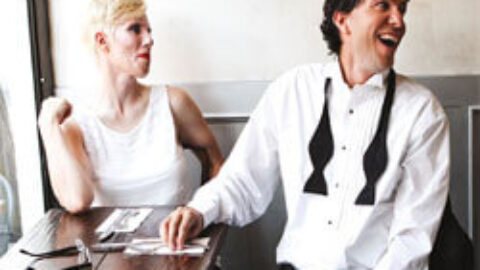American flute and marimba duo Lawler + Fadoul have worked together for over ten years, and listeners will immediately sense their collaborative spirit from the moment they open the packaging of Prelude Cocktail, the duo’s debut CD devoted entirely to preludes. The stunning photography by Julie Lemberger creates an atmosphere that is welcoming and anything but pretentious. Flutist Zara Lawler and percussionist Paul Fadoul’s genuine love of making music together is felt before a single note is heard, and this sentiment sets an excellent precedent for the actual content of this CD.

Prelude Cocktail introduces a wide palette of new pieces for flute and percussion duos as part of Lawler + Fadoul’s Gronica Project, a program that continues to increase the repertoire for their instrumentation through commissioning and arranging. Every track on this CD is a world premiere recording and provides a response to the often-recycled “greatest hits” for flute and percussion. Audiences need no longer assume that “Flute and Percussion recital” is synonymous with “Works by: Arvo Pärt, Astor Piazzolla, and Toru Takemitsu!” By introducing arrangements of Bach, Chopin, Scriabin, Debussy, Gershwin, and Shostakovich alongside newly commissioned works by Katherine Hoover and Roshanne Etezady, Lawler + Fadoul gives ensembles with this instrumentation a new accessibility.
One of the most engaging recordings on this CD is Lawler + Fadoul’s interpretation of selections from J.S. Bach’s The Well-Tempered Clavier, Books 1 & 2. These preludes and fugues have been defined by timbral homogeneity for nearly four centuries, but these brilliantly crafted arrangements confine one voice to a contrasting timbre. While this timbral contrast occurs out of necessity due to the nature of this ensemble, the isolation of the single voice carried by the flute provides the listener with a reimagined hearing of these works, particularly in highly contrapuntal fugal passages. Lawler and Fadoul both execute the phrasing and breath of the baroque style masterfully, and Fadoul’s virtuosic technique is especially impressive as he handles the complex interaction of multiple fugue voices with ease.
The three Chopin preludes from his Op. 28 form a lovely short concert suite as the composite harmonic progression from E minor–B Major–G-sharp minor creates a logical tonal structure. The simplistic beauty of the Scriabin selections showcases Lawler’s marvelous control over a variety of hugely varied tonal colors. The four Debussy preludes are some of the most sonically varied selections combining piccolo, C flute, vibraphone, and marimba in nearly every possible permutation. This constant timbral shift keeps the ensemble sound fresh and engaging.
Lawler + Fadoul’s arrangement of Gershwin’s Three Preludes presents a world of new possibilities for this well-known work. The sheer fact that the flute is a sustaining instrument capable of making a crescendo creates many phrasing opportunities that are not possible in Gershwin’s original piano setting. The combination of alto flute and vibraphone in the Blue Lullaby creates a wonderful dark timbre that contrasts the C flute and marimba instrumentation of the outer movements. The eight selections from Shostakovich’s Preludes, Op. 34 exhibit finely nuanced phrases and demonstrate the magnificently intuitive ensemble playing of this duo. The selections from Shostakovich’s Preludes and Fugues Op. 87 provide a compelling harmonic contrast to the Bach Well-Tempered Clavier excerpts, and guest clarinetist Christopher Grymes seamlessly assimilates into the ensemble.
 Prelude Cocktail concludes with two newly-commissioned works by Katherine Hoover and Roshanne Etezady. The first of Katherine Hoover’s two preludes primarily employs the marimba as a single-line instrument that interacts with the flute as an equal melodic partner. Hoover also incorporates flutter tonguing in the flute to match the texture of the marimba’s sustaining roll. Roshanne Etezady’s Three Preludes demands a high level of ensemble interaction, and this is precisely where Lawler + Fadoul excels. The first movement, Stop, requires the flutist to match the articulation and decay of the marimba through a series of isolated chords, and Lawler does so with consistency and finesse. The ensemble precision throughout the entire work never falters, and the technical execution is pristine.
Prelude Cocktail concludes with two newly-commissioned works by Katherine Hoover and Roshanne Etezady. The first of Katherine Hoover’s two preludes primarily employs the marimba as a single-line instrument that interacts with the flute as an equal melodic partner. Hoover also incorporates flutter tonguing in the flute to match the texture of the marimba’s sustaining roll. Roshanne Etezady’s Three Preludes demands a high level of ensemble interaction, and this is precisely where Lawler + Fadoul excels. The first movement, Stop, requires the flutist to match the articulation and decay of the marimba through a series of isolated chords, and Lawler does so with consistency and finesse. The ensemble precision throughout the entire work never falters, and the technical execution is pristine.
Zara Lawler and Paul Fadoul have proven themselves to be brilliant ensemble musicians and arrangers in addition to being skilled performers on their respective instruments. Their collaborative energy is perhaps the most impressive aspect of this CD. This duo brings new life to works of centuries past through creative arrangements that exploit the timbral possibilities of their instrumentation while simultaneously expanding the repertoire for flute and percussion duos.
Prelude Cocktail, by Lawler + Fadoul (Lawler + Fadoul, 2013)
























